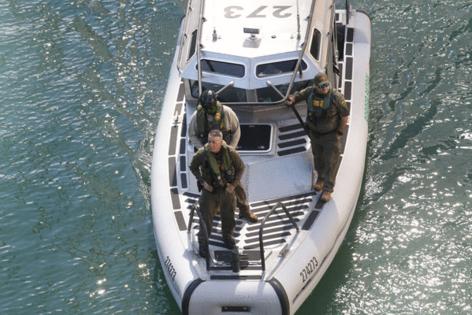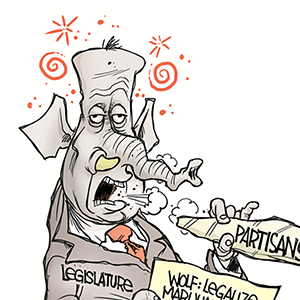Border Patrol's strong-arm tactics are the new norm in Chicago as Trump moves to sideline ICE leadership
Published in News & Features
Cameras rolling, Border Patrol chief Gregory Bovino sailed down the Chicago River in a convoy of government boats. His men held rifles as videographers filmed the stunt later posted to their social media.
The Trump administration had just launched an operation in the city to pursue “the worst of the worst” criminal undocumented immigrants. Homeland Security used the footage for a music video set to Alice in Chains’ “Rooster” ending with Bovino smiling into the distance.
In Chicago, the Sept. 25 moment was widely mocked. Would the federal government be hunting migrants at Navy Pier? Boarding boat tours to find undocumented architecture enthusiasts? Patrolling the Riverwalk?
But more than a month after Bovino and the crew of camouflaged agents he calls the “green machine” arrived in Chicago to assist Trump’s immigration crackdown dubbed Operation Midway Blitz, the scene signaled a profound shift in how the federal government arrests undocumented immigrants far from the border.
Instead of carefully targeted arrests long practiced by the U.S. Immigration and Customs Enforcement, President Donald Trump’s administration has deployed roving groups of masked Border Patrol agents, who work within U.S. Customs and Border Protection. These agents have roamed throughout Chicago and its suburbs with the mission of arresting as many undocumented immigrants as possible, often while camera operators film for future government promotional videos.
Allegations have mounted that Border Patrol agents under Bovino’s command are indiscriminately throwing tear gas in Chicago neighborhoods and using inappropriate force against residents during protests over the Trump administration’s ongoing immigration enforcement push, leading to a federal judge requesting Bovino to debrief her daily on his agents’ actions.
“What we’re seeing now is what the rest of the nation can expect,” said Fred Tsao, senior policy counsel at the Illinois Coalition for Immigrant and Refugee Rights. “This is the new model.”
Since Bovino and his agents arrived, the number of arrests has risen sharply, but so have reports of excessive force and unlawful detentions, including of U.S. citizens. Homeland Security Secretary Kristi Noem said Thursday while speaking in Gary, Indiana, that agents have arrested 3,000 people in the operation, which began in early September.
While the agency’s actions have generated significant legal challenges for the government and public pushback from angry residents, the Trump administration is doubling down on the approach.
Trump is reassigning at least half the top leadership at Immigration and Customs Enforcement offices around the country in a major shake-up of the agency responsible for carrying out the president’s vision for mass deportations, The Associated Press reported.
The Trump administration’s move to sack ICE middle managers around the country and potentially replace some of them with Border Patrol officials suggests White House support for the aggressive mass deportation raids.
“This is one team, one fight,” said U.S. Department of Homeland Security Assistant Secretary Tricia McLaughlin in a statement. “This operation is targeting the worst of the worst criminal illegal aliens in Chicago. ICE and Border Patrol have already arrested more than 3,000 illegal aliens, including rapists, murderers, and gang members.”
Historically, ICE handles the government’s deportation efforts within the country’s interior while Border Patrol works along the border and ports of entry. While ICE has its own legacy of alleged human rights abuses and constitutional violations, its operations tend to be more targeted and focused, experts told the Tribune.
Border Patrol by contrast is known for aggressive pursuits of immigrants far from the big-city spotlight, along the rural Mexican border, where drug cartels and harsh desert conditions generate danger — conditions that are in stark contrast to Chicago’s neighborhoods, where homes are adorned with Halloween decorations and schools hosting fall festivals.
The Border Patrol’s arrival in Chicago drew confusion from some residents who noted the city is hundreds of miles from Canada and more than 1,000 away from the Rio Grande. But McLaughlin says, “While the U.S. Border Patrol primarily operates within 100 air miles of the border, the legal framework provided by the Immigration and Nationality Act … and other laws allows them to operate anywhere in the United States.”
But unlike ICE’s once-targeted operations, Border Patrol’s arrests now appear arbitrary. Agents drive up and down residential streets and stop mostly brown people seemingly at random — landscapers, pedestrians, construction workers — demanding to know, “Where were you born?” or “Are you a U.S. citizen?”
Experts warn that this aggressive approach will likely fuel greater abuses of civil and human rights, heighten public anger and lead to more warrantless arrests, straying far from the previous stated focus on “the worst of the worst.”
For weeks, residents have reported the presence of heavily armed federal agents conducting high-profile sweeps across neighborhoods from Little Village to the western suburbs. Videos show officers in military-style gear confronting pedestrians, blocking intersections and deploying tear gas in confrontations spanning eight different neighborhoods.
Within the Department of Homeland Security, ICE and Border Patrol have a long-standing rivalry with different cultures and approaches around immigration enforcement, experts told the Tribune.
“I think of Border Patrol and ICE as two siblings that don’t always like each other,” said Claire Trickler-McNulty, a former top official at ICE.
Border Patrol historically has a far bigger budget and a bigger staff. ICE officers often wear suits and deal more with longer-term case management, while Border Patrol are uniformed officers who often patrol dark roads in the countryside along the border.
Contrasting ICE with Border Patrol, McNulty said, “Their mode of operation, generally, is based on targeting. Border Patrol is based on trying to stop anybody trying to cross the border. It’s just a wider-net approach.”
Katherine Hawkins, a legal analyst with the Project on Government Oversight, explained more differences between ICE and Border Patrol.
“ICE officers are very on board with deporting people, but they usually do it in a certain way where it’s focused on people who have come into contact with the criminal justice system,” Hawkins said. “It tends to be focused on going after particular individuals. They might stake out someone’s house.”
But that isn’t what the Trump administration wants, Hawkins said.
“I think they’ve realized that Border Patrol gives them extra manpower and probably less pushback when they’re told to just go round up everyone,” she said.
Trump campaigned for president on a platform pledging mass deportations of immigrants while restricting future influxes into the country. How to best implement his desire is a logistical challenge due to limited detention space, manpower and constitutional safeguards that slow down government officials’ wishes.
Scott Shuchart, a former high-ranking ICE official, said immigration enforcement has always focused on a debate over how to best use the government’s manpower.
“Are the resources going to be deployed to get people who are dangerous or are they going to be deployed to get the easiest people?” Shuchart said. “I think what we’re seeing is one side finally winning that argument.”
A recent Supreme Court decision allowing agents to take the ethnic background of a person into consideration in some circumstances has cleared the way for more aggressive patrolling, Shuchart said, referring to what some are calling “Kavanaugh stops.”
In September, the conservative majority on the Supreme Court lifted a restraining order from a judge who found that roving patrols were conducting indiscriminate stops in and around Los Angeles. The order had barred immigration agents from stopping people solely based on their race, language, job or location.
The majority did not explain its reasoning, as is typical on the court’s emergency docket. But Justice Brett Kavanaugh said the lower-court judge had gone too far in restricting how federal immigration agents can carry out brief stops for questioning, The Associated Press reported.
“A lot of what Border Patrol was doing was illegal until a couple months ago. It was racial profiling,” Shuchart said. “Then the Supreme Court decided racial profiling doesn’t count if they’re working-class Latinos.”
A significant part of the Trump administration’s approach to immigration revolves around using social media to claim undocumented immigrants are driving crime in big cities even though statistics show they are less likely to commit violent crimes than U.S. citizens.
Dan Herman, a former senior adviser to the commissioner of Customs and Border Protection, said much of the current approach favored by Bovino and the White House is more about sending a political message.
“What we are seeing is, when you put law enforcement in a role that is not what they’ve been trained or equipped or have the appropriate authorities for, you can have mistakes and improper behavior, unprofessional behavior,” Herman said. “It’s really about the theater of these things.”
Bovino himself is an example, Herman said.
In the first week of January, before Trump’s inauguration, Bovino sent 60 agents hundreds of miles to Bakersfield, California, to make 78 arrests at farms and businesses. His staff acknowledged congratulatory comments on social media and posted photos of an encounter with someone whose car window was shattered after refusing to open it, The Associated Press reported.
“He was trying to get the attention of the new administration and show he was interested in spectacle, not security,” Herman said. “I think the administration is trying to reward that attitude, and there’s a reason they’ve used him as their incident commander in these high-profile operations.”
Border Patrol’s presence has consequences far beyond the immigrants being targeted. Local restaurants and businesses in Latino areas and their neighboring communities are experiencing deep financial woes as customers stay home.
Chicago’s rapid-response volunteers, who monitor enforcement operations and document abuses, have become targets. Many have been arrested for recording agents, following agents or alerting people of federal agents in a neighborhood.
Residents have angrily confronted Border Patrol agents throughout the city in several confrontations, leading the feds to deploy tear gas in neighborhoods from working-class East Side to wealthy Lakeview.
“What immigration enforcement looks like now is not just arrests,” Tsao said. “It’s public intimidation.”
Tsao noted that U.S. citizens are not required to carry proof of citizenship, but many people of color have begun doing so anyway out of fear. “I know people who carry their passports everywhere or keep photos of them on their phones,” he said. “That’s what this climate has created.”
For Tsao and others, the concern extends beyond one city. “Chicago is showing the rest of the country what this new era of immigration enforcement looks like,” he said. “The border has come to the interior. The border has come to Chicago.”
_____
©2025 Chicago Tribune. Visit chicagotribune.com. Distributed by Tribune Content Agency, LLC.







Comments